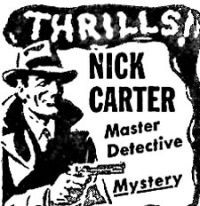
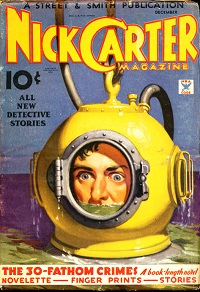 Nick Carter, Master Detective (1943-1955) aired “The Case of the Phantom Shoplifter” on Christmas night, December 25, 1949. This is the 16th Nick Carter episode we’ve run since 2009, and only the 3rd since August of 2020 (the two previous episodes airing in February and August of 2021). Carter’s history is long, covers numerous media, and is one of the more fascinating we’ve come upon. To crib from one of our earlier entries for new listeners, and slightly tweaked with new material, Nick Carter on radio ran a respectable twelve years, from 1943-1955, but the famous detective’s history begins much earlier. During the post-Civil War era known as Reconstruction, a short story featuring Carter appeared in an obscure fiction paper (The New York Weekly) in 1886 (predating the first Sherlock Holmes story by two years). The publisher was none other than Street & Smith, a fledgling, struggling publishing firm which would later become the most dominant pulp magazine publisher in the world. Among its later titles would be Astounding Science Fiction (now Analog), the only magazine from Street & Smith to survive the pulp magazine crash of the 1950s.
Nick Carter, Master Detective (1943-1955) aired “The Case of the Phantom Shoplifter” on Christmas night, December 25, 1949. This is the 16th Nick Carter episode we’ve run since 2009, and only the 3rd since August of 2020 (the two previous episodes airing in February and August of 2021). Carter’s history is long, covers numerous media, and is one of the more fascinating we’ve come upon. To crib from one of our earlier entries for new listeners, and slightly tweaked with new material, Nick Carter on radio ran a respectable twelve years, from 1943-1955, but the famous detective’s history begins much earlier. During the post-Civil War era known as Reconstruction, a short story featuring Carter appeared in an obscure fiction paper (The New York Weekly) in 1886 (predating the first Sherlock Holmes story by two years). The publisher was none other than Street & Smith, a fledgling, struggling publishing firm which would later become the most dominant pulp magazine publisher in the world. Among its later titles would be Astounding Science Fiction (now Analog), the only magazine from Street & Smith to survive the pulp magazine crash of the 1950s.
(Top right: Nick Carter Magazine, Dec. 1934)
Award-winning radio historian Elizabeth McLeod notes that, “Within a decade, an ongoing series of Nick Carter novels vaulted [Street & Smith] to the front ranks of dime-novel publishers, and made Nick himself a national institution. Nick’s own magazine, The New Nick Carter Weekly, would carry the detective into the twentieth-century.” By 1915, however, the then titled Nick Carter Weekly became Street and Smith’s Detective Story Magazine, a true pulp magazine and S&S’s initial entry into this new format. Again, from Elizabeth McLeod: “Detective Story Weekly soon became Street and Smith’s flagship publication. With the rise of radio in the 1920s, it became the firm’s entree into the broadcast medium. The Street and Smith Detective Story Hour became a favorite of listeners at decade’s end, with elaborate tales of murder and crime hosted by a mysterious narrator introduced only as “The Shadow.” While Nick Carter himself did not appear on the program, his spirit was very much in evidence in the various detective characters that populated the stories.” Of course, we all know what happened next. The mysterious voice only introducing the S&S Detective Story Hour became so popular that S&S launched The Shadow magazine in 1931, and shortly thereafter S&S added Doc Savage to its pulp adventure line. Amidst all of this activity Nick Carter was even given his own magazine (again) in 1933, proving the character’s resiliency and staying power–he was now 47 years old.
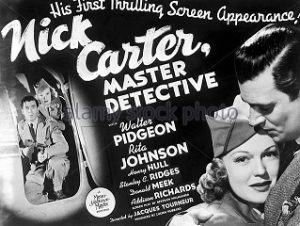 Nick Carter Magazine ran for 40 issues, from March 1933 to June 1936, the final six issues slightly retitled as Nick Carter Detective Magazine. While the magazine had folded, its long-running character still lived, for in 1939 Hollywood picked up the movie rights and produced three “B” Carter films starring noted actor Walter Pidgeon* (who later would star in the classic 1956 SF film Forbidden Planet). A mere three years later, Nick
Nick Carter Magazine ran for 40 issues, from March 1933 to June 1936, the final six issues slightly retitled as Nick Carter Detective Magazine. While the magazine had folded, its long-running character still lived, for in 1939 Hollywood picked up the movie rights and produced three “B” Carter films starring noted actor Walter Pidgeon* (who later would star in the classic 1956 SF film Forbidden Planet). A mere three years later, Nick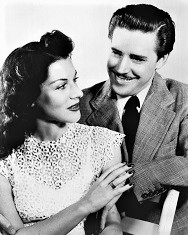 Carter would rise from the dead yet again in his own radio series, Nick Carter, Master Detective. The show’s producer and often the writer, Sherman “Jock” MacGregor, would enlist some of the best writers in the business to script Carter’s episodes, including Robert Arthur and David Kogan of Mysterious Traveler fame, the creator of The Shadow, Walter Gibson, and none other than legendary SF author Alfred Bester (one of which Bester-written episodes, “Chemical Chickens,” we ran in March of 2014 here). Lon Clark played Nick Carter throughout its 12-year run, ably supported by first Helen Choate until mid-1946 and then Charlotte Manson (photo above right) as Nick’s intelligent, perky secretary Patsy Bowen. Other mainstay characters included Police Sergeant Matty Mathieson, young newspaper reporter Scubby Wilson, and scruffy old veteran of the crime game Waldo McGlynn.
Carter would rise from the dead yet again in his own radio series, Nick Carter, Master Detective. The show’s producer and often the writer, Sherman “Jock” MacGregor, would enlist some of the best writers in the business to script Carter’s episodes, including Robert Arthur and David Kogan of Mysterious Traveler fame, the creator of The Shadow, Walter Gibson, and none other than legendary SF author Alfred Bester (one of which Bester-written episodes, “Chemical Chickens,” we ran in March of 2014 here). Lon Clark played Nick Carter throughout its 12-year run, ably supported by first Helen Choate until mid-1946 and then Charlotte Manson (photo above right) as Nick’s intelligent, perky secretary Patsy Bowen. Other mainstay characters included Police Sergeant Matty Mathieson, young newspaper reporter Scubby Wilson, and scruffy old veteran of the crime game Waldo McGlynn.
*(The first of the three Nick Carter films was 1939’s Nick Carter, Master Detective. Of interest to SF genre buffs is that it was directed by Jacques Tourneur, now famous for directing the following trio of Val Lewton horror films: Cat People (1943), I Walked with a Zombie (1943), and The Leopard Man (1943).)
From Nick Carter’s beginnings in 1886 through his final radio show in 1955, Carter would change with the times; from clean-living detective (actually, at the beginning of his career, Nick was a private investigator and consulting detective to the police department, much like Sherlock Holmes, and did not work as a police detective), master of disguise, to anti-espionage agent, to the bane of mad scientists or the defender of scientists beset by crooks, Nick Carter has enjoyed one of the longest surviving, most popular runs in various media for over 100 years, for when his radio show ended in 1955 he would resurface (yet again!) in a series of James Bond-type paperback novels in the 1960s which ran into the 1990s, quite a few of them written by women.

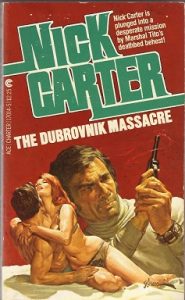

Virtually forgotten today, Nick Carter predates Sir Arthur Conan Doyle’s Sherlock Holmes, Dashiell Hammett’s Sam Spade, Raymond Chandler’s Philip Marlowe, and was originally inspired by the real-life exploits of private investigator Allan Pinkerton.
“The Case of the Phantom Shoplifter” involves Nick brought into a case of shoplifting—the shoplifting of expensive fur coats worth around $3,000 apiece, for a total in the neighborhood of $36,000. And in 1949 dollars that is a major bit of shoplifting more in the neighborhood of grand larceny. Tracking down the clever criminal involves some astute deductions and patience, but unlike today, once caught the criminal is not set free, so enjoy this entertaining caper that proves no match for Nick Carter, Master Detective. (And we hope from Nick Carter uncovering the slick theft scheme we are not revealing any secrets for would be criminals.)
Play Time: 29:54
{This episode of Nick Carter aired on Christmas evening, a Sunday, in 1949. With their pockets a little heavier and jingling with Christmas money from relatives, it was a sure bet the neighborhood gang would gather at the nearby newsstand the next morning (thank goodness for Christmas vacation) to compare their booty with which they intended to enlarge their pulp magazine collections. New Detective (1941-55) had been a solid choice in the past, and with its stated promise of featuring crime stories with an emphasis on police detectives it found its audience. It was a bi-monthly in 1949. Popular Detective (1934-53) was a more “basic” (as one source termed it) detective magazine but through its 19-year existence and 133 issues made its bones by running stories of consistently high quality by many of the top shelf authors of the time. It too was a bi-monthly in 1949. Private Detective (1937-50) appeared a few years after the debut of what came to be known as the “spicy” genre pulps, those detective and mystery offerings laced with sex and featuring lurid covers. Private Detective was thought of as “spicy” light, though one observation made was that it still retained a goodly portion of the psychopathology written into some of its seedier characters in order to keep happy those readers drawn to the dark, twisted edges of normal behavior. It held to an unbroken monthly schedule until 1946 when it began to appear erratically, with the number of issues from 1946-1950 ranging from 4 to 9.}
[Left: New Detective, 11/49 – Center: Popular Detective, 12/49 – Right: Private Detective, 11/49]
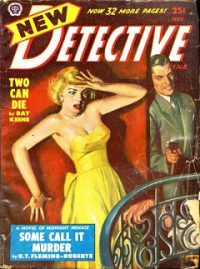
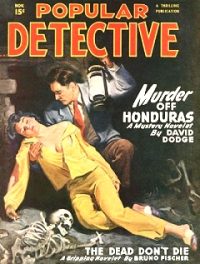
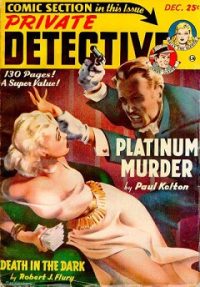
To view the entire list of weekly Old Time Radio episodes at Tangent Online, click here.